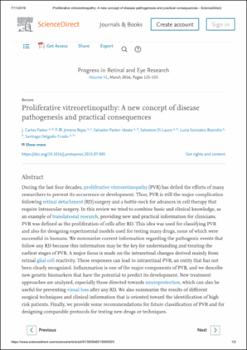| dc.contributor.author | Pastor, Juan C. | |
| dc.contributor.author | Rojas, Jimena. | |
| dc.contributor.author | Pastor-Idoate, Salvador. | |
| dc.contributor.author | Di Lauro, Salvatore. | |
| dc.contributor.author | Gonzalez-Buendia, Lucia. | |
| dc.contributor.author | Delgado-Tirado, Santiago. | |
| dc.date.accessioned | 2019-11-07T19:05:57Z | |
| dc.date.available | 2019-11-07T19:05:57Z | |
| dc.date.issued | 2016-03-01 | |
| dc.identifier.citation | Prog Retin Eye Res. 2016 Mar;51:125-55. | en_US |
| dc.identifier.issn | 1350-9462 | |
| dc.identifier.uri | https://riu.austral.edu.ar/handle/123456789/753 | |
| dc.description.abstract | During the last four decades, proliferative vitreoretinopathy (PVR) has defied the efforts of many researchers to prevent its occurrence or development. Thus, PVR is still the major complication following retinal detachment (RD) surgery and a bottle-neck for advances in cell therapy that require intraocular surgery. In this review we tried to combine basic and clinical knowledge, as an example of translational research, providing new and practical information for clinicians. PVR was defined as the proliferation of cells after RD. This idea was used for classifying PVR and also for designing experimental models used for testing many drugs, none of which were successful in humans. We summarize current information regarding the pathogenic events that follow any RD because this information may be the key for understanding and treating the earliest stages of PVR. A major focus is made on the intraretinal changes derived mainly from retinal glial cell reactivity. These responses can lead to intraretinal PVR, an entity that has not been clearly recognized. Inflammation is one of the major components of PVR, and we describe new genetic biomarkers that have the potential to predict its development. New treatment approaches are analyzed, especially those directed towards neuroprotection, which can also be useful for preventing visual loss after any RD. We also summarize the results of different surgical techniques and clinical information that is oriented toward the identification of high risk patients. Finally, we provide some recommendations for future classification of PVR and for designing comparable protocols for testing new drugs or techniques. | en_US |
| dc.language.iso | en | en_US |
| dc.publisher | Elsevier B.V. ScienceDirect | en_US |
| dc.subject | Proliferative vitreoretinopathy | en_US |
| dc.subject | Pathogenesis | en_US |
| dc.subject | Genetics | en_US |
| dc.subject | Classification | en_US |
| dc.subject | Clinical trial | en_US |
| dc.subject | Adjuvants | en_US |
| dc.subject | Treatment | en_US |
| dc.subject | Surgery | en_US |
| dc.subject | Prophylaxis | en_US |
| dc.title | Proliferative vitreoretinopathy: A new concept of disease pathogenesis and practical consequences. | en_US |
| dc.type | Article | en_US |


